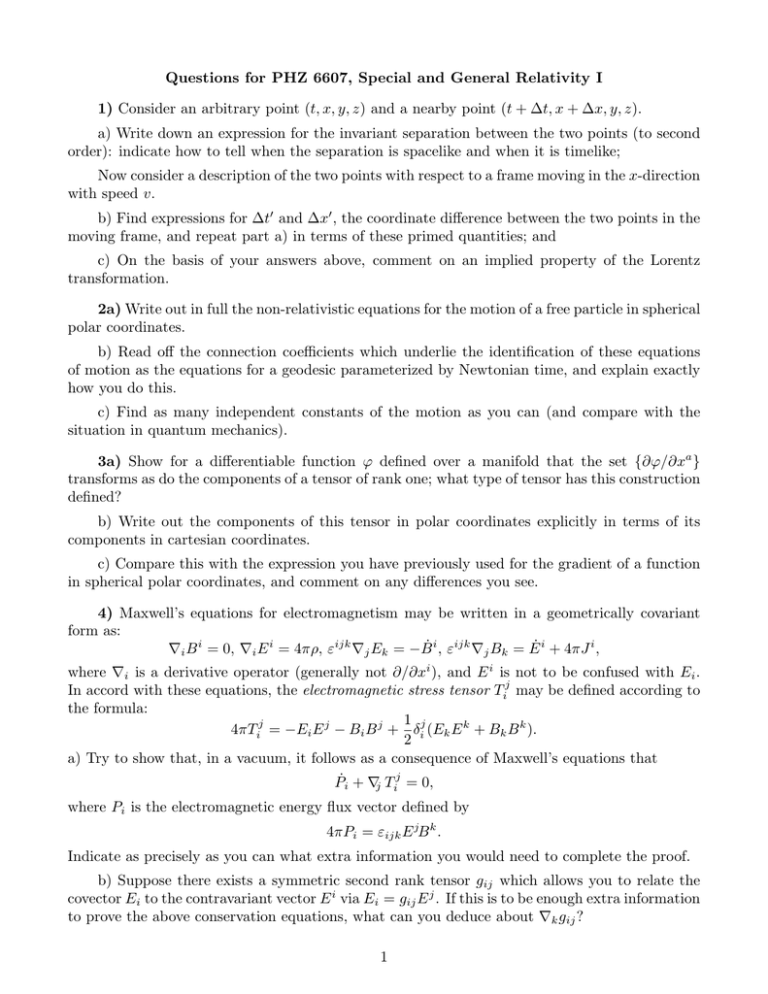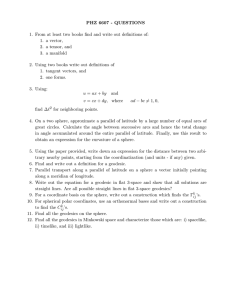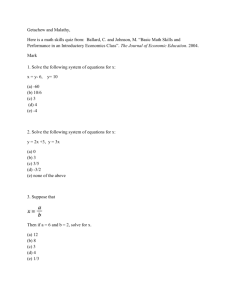Questions for PHZ 6607, Special and General Relativity I 1)
advertisement

Questions for PHZ 6607, Special and General Relativity I
1) Consider an arbitrary point (t, x, y, z) and a nearby point (t + ∆t, x + ∆x, y, z).
a) Write down an expression for the invariant separation between the two points (to second
order): indicate how to tell when the separation is spacelike and when it is timelike;
Now consider a description of the two points with respect to a frame moving in the x-direction
with speed v.
b) Find expressions for ∆t′ and ∆x′ , the coordinate difference between the two points in the
moving frame, and repeat part a) in terms of these primed quantities; and
c) On the basis of your answers above, comment on an implied property of the Lorentz
transformation.
2a) Write out in full the non-relativistic equations for the motion of a free particle in spherical
polar coordinates.
b) Read off the connection coefficients which underlie the identification of these equations
of motion as the equations for a geodesic parameterized by Newtonian time, and explain exactly
how you do this.
c) Find as many independent constants of the motion as you can (and compare with the
situation in quantum mechanics).
3a) Show for a differentiable function φ defined over a manifold that the set {∂φ/∂xa }
transforms as do the components of a tensor of rank one; what type of tensor has this construction
defined?
b) Write out the components of this tensor in polar coordinates explicitly in terms of its
components in cartesian coordinates.
c) Compare this with the expression you have previously used for the gradient of a function
in spherical polar coordinates, and comment on any differences you see.
4) Maxwell’s equations for electromagnetism may be written in a geometrically covariant
form as:
∇i B i = 0, ∇i E i = 4πρ, εijk ∇j Ek = −Ḃ i , εijk ∇j Bk = Ė i + 4πJ i ,
where ∇i is a derivative operator (generally not ∂/∂xi ), and E i is not to be confused with Ei .
In accord with these equations, the electromagnetic stress tensor Tij may be defined according to
the formula:
1
4πTij = −Ei E j − Bi B j + δij (Ek E k + Bk B k ).
2
a) Try to show that, in a vacuum, it follows as a consequence of Maxwell’s equations that
Ṗi + ∇j Tij = 0,
where Pi is the electromagnetic energy flux vector defined by
4πPi = εijk E jB k .
Indicate as precisely as you can what extra information you would need to complete the proof.
b) Suppose there exists a symmetric second rank tensor gij which allows you to relate the
covector Ei to the contravariant vector E i via Ei = gij E j . If this is to be enough extra information
to prove the above conservation equations, what can you deduce about ∇k gij ?
1
Questions for PHZ 6607, Special and General Relativity I
5a) Using the Lagrangian
1
mgµν x˙µ x˙ν ,
2
in cartesian (spatial) coordinates, find expressions for the conserved linear and angular canonical
momenta px , py , pz , Lx , Ly and Lz , in terms of the ‘velocities’.
£=
b) Similarly, starting with the Lagrangian written in spherical polar coordinates, find expressions for the canonical momenta pr , pθ and pϕ in terms of the ‘velocities’ which arise for these
coordinates.
c) Use the coordinate relations:
x = r sin θ cos ϕ,
y = r sin θ sin ϕ and ,
z = r cos θ
write down the relations giving the cartesian velocities in terms of the polar velocities.
d) Hence, obtain expressions for all the conserved momenta listed in part a) in terms of the
canonical momenta for polar coordinates.
e) What type of tensor are the velocities and what type the momenta? (This difference
explains why it is dangerous to go directly from the velocities in one set of coordinates to the
momenta in another. It also explains why p·x is always a scalar.)
6) Consider the four-dimensional spacetime metric which in {t, r, θ, ϕ} coordinates has diagonal components {−(1 − rs /r), 1/(1 − rs /r), r2 , r2 sin2 θ}, all other components being zero. Notice
that in the usual sense, the parameter rs has the dimensions of length.
a) Write out expressions for the canonical momenta of a particle whose Lagrangian is given
by:
1
mgµν x˙µ x˙ν , in which ˙ = d/dλ,
2
in which the spacetime geometry is given by this metric.
£=
b) Write out Hamilton’s equations of motion for this particle, and indicate which canonical
momenta are conserved.
c) By explicit calculation, show that all components of the angular momentum which were
defined in Question 5) are in fact conserved for the particle moving in this non-flat geometry.
Hence, or otherwize, argue whether or not this spacetime is spherically symmetric.
d) Find an expression for dr/dϕ, assuming the motion takes place in the equatorial plane.
Obtain the corresponding equation for a particle of mass m moving under Newtonian gravity
around a central body of mass M.
e) Using your knowledge of the difference between Newtonian physics and relativistic physics,
and by assuming that the motion takes place in a region where both |v|/c the ratio rs /r are small,
indicate how the resulting motion in this spacetime can be compared with motion in a Newtonian
gravitational potential, and find the implied correspondence between the parameter rs and the
mass causing the potential: if you have used c = 1, restore it in the final relation you obtain.
2




